It might be the worst part about horses, it’s not getting out of bed to go feed, it’s not changing the blankets according to the weather, it’s not cleaning stalls, it’s the flies!
Those pesky buzzing, biting nuisances that come every year about this time.
Flies annoy us; they bite us and our horses. Horses are so busy stomping and swishing tails that they cannot stand still for grooming, saddling, mounting and certainly not for the farrier. Worse yet you can get caught in the path of a flying foot or tail and your horse had no intention to hurt you he just wants the flies off of his body.

Flies carry and transmit disease. Flies cause dermatitis by biting the skin to get their blood meal. Saliva from the fly can cause an allergic reaction in the horse that causes severe rubbing, hair loss and damage to the skin. Screwworms and maggots are caused by flies who deposit their larvae in skin wounds. Parasites such as Habronema are fly larvae that cause open sores to develop that will not heal. Onchocerca worms are transmitted by flies and can cause blindness. Stomach bots are fly larvae that develop into inch long worms in the horses’ stomach. Fungal infections such as Phycomycosis are also transmitted by biting flies.
Horses that are living in heavily infested areas may spend so much time and energy stomping, swishing and biting at flies that weight loss can be a problem. The crusted blood on the legs from fly bites only serves to draw even more flies and vicious cycle ensues.
Aesthetically as owners of stables we would like to provide an optimum environment for our horses and their owners. Controlling flies becomes a mandatory part of stable management. But what if it’s just your own property? You too have a responsibility to manage your horses so that you do not become a nuisance to your neighbors. This is particularly true for horse owners who live on small acreage in subdivisions or mini-farms. Controlling flies makes stables more attractive to future customers, visitors, and the professionals that visit your farm including your farrier and veterinarian.
So, what can you do to control flies? Fly season is upon us. First you need to know the enemy. I found a great resource of information about flies at Spalding Laboratories. I learned a lot about flies from them. Here’s is what they had to say about fly biology.
Basic Fly Biology
It’s been said that every creature has its purpose. For flies their purpose is to decompose rotting organic matter such as manure, dead plants and animals. If you have an abundance of material needing decomposition, you get an abundance of flies.
Flies have four stages in their life cycle (shown in the diagram). Adult House Flies lay eggs on or close to a larval food source of rotting organic matter (i.e., manure but also compost piles, rotting hay, etc.) the eggs hatch within hours into larvae (maggots). The larvae feed and then in no less than 5 days they pupate forming a cocoon. Inside this cocoon they metamorphosis into an adult fly which takes at least 3 days.
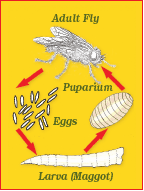
This is the same process a caterpillar goes through as it turns into a butterfly. You can use these minimum transformation days to your advantage.
The pupa is light to dark brown and looks very much like a dark grain of rice or a rodent dropping. This is the stage the Fly Predator takes over killing that immature fly. The pupa is also the stage that flies “hibernate” when the temperature drops below 47°F allowing them to make it through the winter. Note there are no “baby” flies, when they emerge from the pupa, they are full size. The smaller flies you see are just different species.
So, it takes 345 days to produce a foal, 63 days to produce a puppy and 8 days to produce a fly!
House Fly
The easiest way to identify the flies that bug you is where they are on your animals. The most common pest fly is the non-biting House Fly. These are “filth flies” as they feed and reproduce on most any rotting organic matter, manure, spoiled feed, garbage, decaying fruit and eyes, but they can be anywhere on your animals.
Lure and capture these flies away from your barn with odor traps.
Inside the barn use non smelly sticky traps
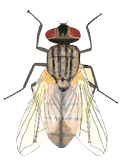
Stable Fly
The second most common fly around horses and the most bothersome is the Stable Fly. These are blood feeders and they hurt when they cut through the skin to feed. You will find these mostly on the fore legs and flanks of horses. If your horses are stomping and twitching, it’s these bad boys (and girls).
These flies reproduce in horse manure as well as rotting vegetation. If coming from horse manure, they typically make up 20% of your fly population. If you have way more than that, then they’re also likely coming from old round bales, or old hay at the bottom of round bale rings, grass clippings, etc. that can be a mile or two away.
Put Fly Predators there or spread the old hay thinly to dry. To capture this fly you need a Biting Stable Fly Trap
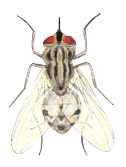
When going into battle you need to have a plan of attack. If you know who the enemy is you need to know where they live.
Are They Your Flies or The Neighbor’s?
If you are at least 1/4 mile away from neighbors with animals then it’s very likely most of your flies. If you have nearer neighbors or ones with lots of animals, then you’ll need to address those flies as well as your own. This calls for persuasion or traps. First try persuading them to use Fly Predators and maybe pickup a bit so they won’t have many flies to send you. If that isn’t going to happen, then add the right type of traps to intercept the different adult flies heading your way.
Fly Control with Horses
The first step is to identify the insect(s) that are plaguing you and your animals. With horses, the majority of your bothersome flies will likely be the House Fly (80%) and the biting Stable Fly (20%). When the fly is identified, then use the methods listed that focus on the prevention and control of that species. This is important as different flies can come from dramatically different places. Preventing flies fixes the problem. Just going after the adult flies you see only affects 15% of the population, the rest will be there bothering you in a week or so.
A key ingredient in fly control is managing your property and particularly your manure. Remember that flies breed in horse manure. You will need to clean stalls daily and compost the manure or have it hauled away frequently. Picking up manure out of paddocks and pastures will go a long way to reduce fly populations but it is labor intensive. They now manufacture pasture vacuums to make this process quicker and easier. Covering your manure pile with black plastic retains heat which kills fly and parasite larvae and stops fly access to manure.
Other steps to help reduce your fly population include raking up old hay, sealing up garbage and mowing the grass. Tall grass and weeds provide a shady rest area for flies. You certainly don’t want to have well-rested flies!
You can also put nature to work for you. Fly Predators are nature’s own enemy of all common manure and rotting organic matter breeding pest flies, including the common house fly, horn fly, biting stable fly and lesser house fly. In the natural environment Fly Predators serve as a major check of pest fly populations by destroying the next generation of flies in their immature pupa (cocoon) stage. Fly Predators are tiny, completely biteless and stingless. They never become a pest themselves. Because of their small size and the fact they live their entire life cycle on or near manure (where the pest fly pupa are typically found), Fly Predators go virtually unnoticed.
Many people just go after adult flies buzzing around but that’s only about 15% of the population at any time. If you don’t stop the future ones you’ll be plagued all summer. Fly Predators break the fly’s life cycle. The hard working Fly Predator moms find and kill roughly 75 pest fly pupae before they hatch. Every female pest fly that doesn’t make it means potentially up to 900 fewer bothersome flies.
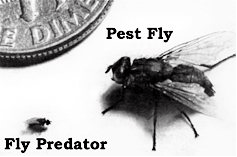
Using a preventive solution like Fly Predators or making the area less “fly friendly” requires that you treat the locations where the pest flies are reproducing. In almost all cases this is NOT where you see the adult flies that are bothering you or your animals. Often you will see the most flies in the barn but it’s highly likely that only a small percentage of those flies came from the barn. Instead they most likely came from the pasture, corrals, the manure pile, the neighbors animals, etc. If you’ve only been spraying, using traps, or baits you have to think differently when using prevention.
The optimum time to start for your area is when the daytime highs get into the 60s. It’s always before the flies are a problem. By starting prior to the first fly hatch there will be relatively few viable fly pupae that survived the winter so the ratio of Fly Predators to fly pupae is high. This allows the Fly Predators to reduce the initial fly breeding population to a very low level which can mean fewer flies all summer.
However, you must release enough Fly Predators to control all the fly reproduction in the area. You treat the farm not the horse. For example, if you board at a commercial stable, ordering Fly Predators for just your horse will not be sufficient as the flies that reproduce in the neighboring (within 1/4 mile) horses’ manure will easily reach your stall.
Fly Traps
Here at CGES we have found fly traps to be very helpful in controlling our fly population. I find that location of the trap is very important. We had tried different brands of traps, some worked great, others were a complete waste of money. After reading about fly traps on the Spalding Laboratories website now I know why! It turns out that depending on the type of fly you need a certain type of trap. Some traps need to be placed low to the ground, others higher. Use the right trap for your situation, including your home, barn and picnic area!
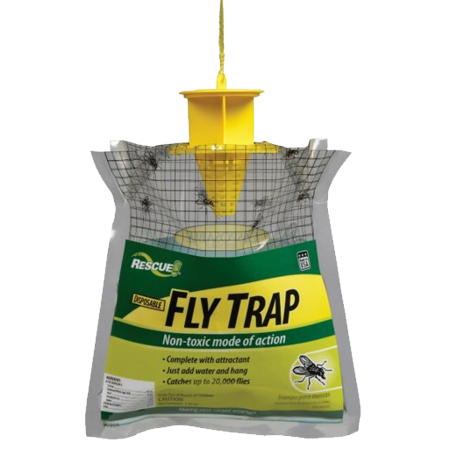
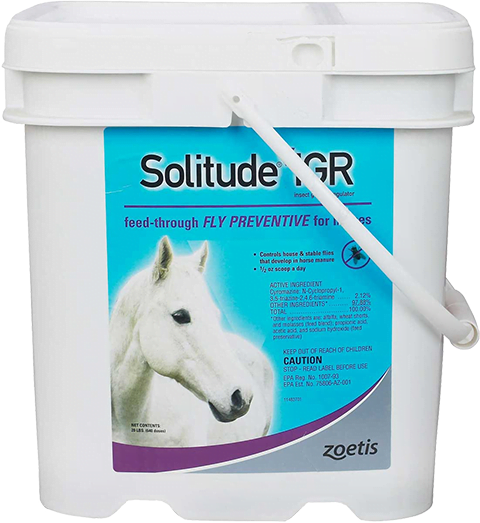
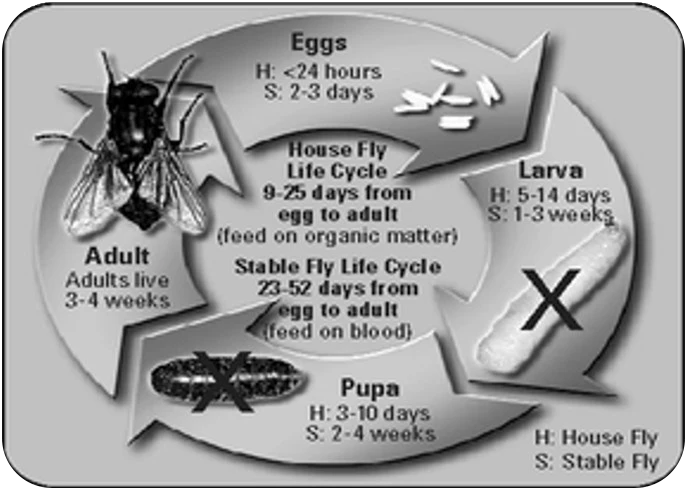
Feed-Through
Another method of fly control is feed-through fly preventive such as “Solitude” (cyromazine). Cyromazine is an insect growth regulator. It blocks the formation of chitin. Chitin is what provides structural support to the exoskeleton. Horses and humans have an endoskeleton, we have bones inside our bodies. Flies have an exoskeleton, without chitin there is no exoskeleton and the fly fails to develop. Cyromazine has no effect on the horse or any mammal such as dogs. The horse acts as a mixer when it eats the product the drug is mixed into the manure. Flies lay there larvae in the manure and the larvae fail to develop. The product is safe for horses of all ages, pregnant mares and stallions.
Cyromazine will not kill existing adult flies. You will need to use other methods to kill these flies. Cyromazine works on both house flies and stable flies. It is important to note the cyromazine is NOT an organophosphate. There are feed-through fly control products on the market that are organophosphates which can have serious side effects on horses, dogs and cats. Horses should not go under anesthesia while on these products making emergency colic surgery an increased anesthetic risk. I do not recommend feeding organophosphates to horses.
Insecticides
Finally there are traditional methods of fly control using fly sprays in barns and on horses. Fly sprays have to be applied frequently. Most fly products today contain pyrethrins or permethrins. The mixing vehicles in some fly spray can be irritating to some people and horses. Other products include concentrated forms of permethrins or pyrethrins that are applied down the horses’ back and legs. These can be very helpful for horses that are not seen and handled daily.
More comprehensive approaches, including initial careful and selective use of insecticides, may be necessary for the fastest control if the pest fly problem has been allowed to become severe. This is due to the fact that most of the “natural” controls prevent future flies but do not affect existing adults. Since adult House Flies live approximately 21 days, you will either need to put up with them for that long or use traps and baits or careful pesticide application to reduce their population rapidly.
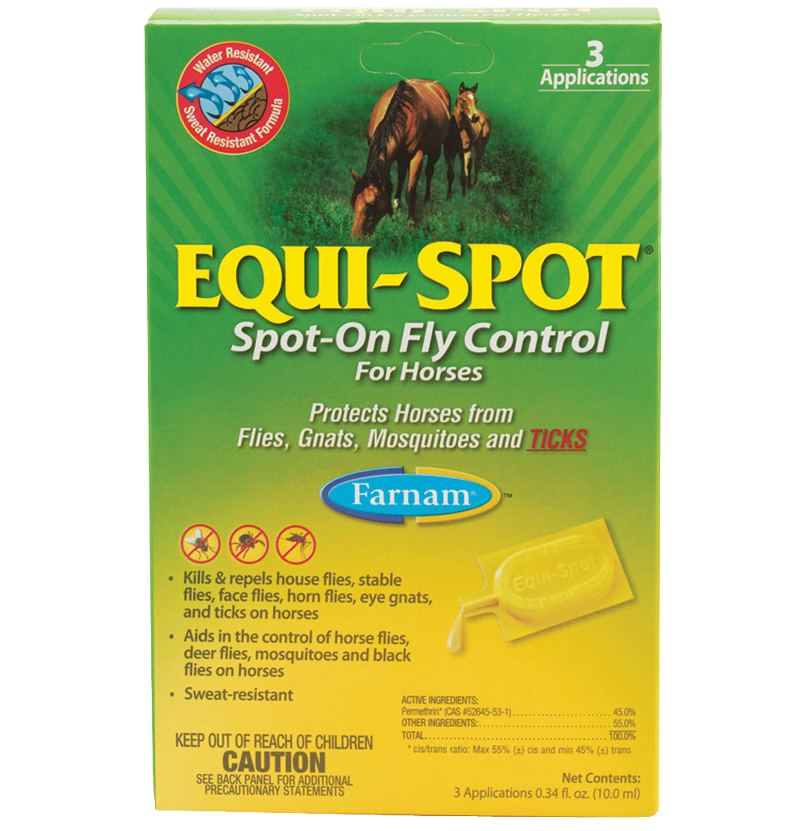
There is no known method of fly control that offers 100% eradication of pest flies.
There are many other types of flies that can make horses and people miserable and riding downright dangerous. If you would like more information about Deer Flies, Horn Flies, Face Flies, Bot Flies, Blow Flies, Dung Flies, Black Flies, Cluster Flies and Mosquitoes visit Spalding Laboratories.

